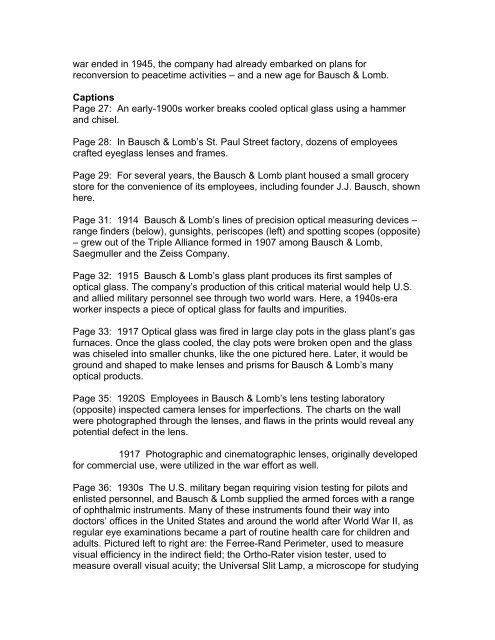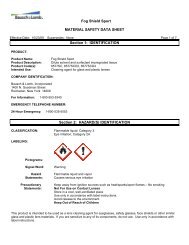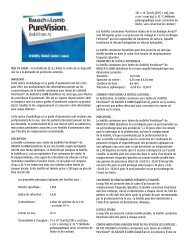Bausch & Lomb Perfecting vision, enhancing life for 150 years A ...
Bausch & Lomb Perfecting vision, enhancing life for 150 years A ...
Bausch & Lomb Perfecting vision, enhancing life for 150 years A ...
You also want an ePaper? Increase the reach of your titles
YUMPU automatically turns print PDFs into web optimized ePapers that Google loves.
war ended in 1945, the company had already embarked on plans <strong>for</strong><br />
reconversion to peacetime activities – and a new age <strong>for</strong> <strong>Bausch</strong> & <strong>Lomb</strong>.<br />
Captions<br />
Page 27: An early-1900s worker breaks cooled optical glass using a hammer<br />
and chisel.<br />
Page 28: In <strong>Bausch</strong> & <strong>Lomb</strong>’s St. Paul Street factory, dozens of employees<br />
crafted eyeglass lenses and frames.<br />
Page 29: For several <strong>years</strong>, the <strong>Bausch</strong> & <strong>Lomb</strong> plant housed a small grocery<br />
store <strong>for</strong> the convenience of its employees, including founder J.J. <strong>Bausch</strong>, shown<br />
here.<br />
Page 31: 1914 <strong>Bausch</strong> & <strong>Lomb</strong>’s lines of precision optical measuring devices –<br />
range finders (below), gunsights, periscopes (left) and spotting scopes (opposite)<br />
– grew out of the Triple Alliance <strong>for</strong>med in 1907 among <strong>Bausch</strong> & <strong>Lomb</strong>,<br />
Saegmuller and the Zeiss Company.<br />
Page 32: 1915 <strong>Bausch</strong> & <strong>Lomb</strong>’s glass plant produces its first samples of<br />
optical glass. The company’s production of this critical material would help U.S.<br />
and allied military personnel see through two world wars. Here, a 1940s-era<br />
worker inspects a piece of optical glass <strong>for</strong> faults and impurities.<br />
Page 33: 1917 Optical glass was fired in large clay pots in the glass plant’s gas<br />
furnaces. Once the glass cooled, the clay pots were broken open and the glass<br />
was chiseled into smaller chunks, like the one pictured here. Later, it would be<br />
ground and shaped to make lenses and prisms <strong>for</strong> <strong>Bausch</strong> & <strong>Lomb</strong>’s many<br />
optical products.<br />
Page 35: 1920S Employees in <strong>Bausch</strong> & <strong>Lomb</strong>’s lens testing laboratory<br />
(opposite) inspected camera lenses <strong>for</strong> imperfections. The charts on the wall<br />
were photographed through the lenses, and flaws in the prints would reveal any<br />
potential defect in the lens.<br />
1917 Photographic and cinematographic lenses, originally developed<br />
<strong>for</strong> commercial use, were utilized in the war ef<strong>for</strong>t as well.<br />
Page 36: 1930s The U.S. military began requiring <strong>vision</strong> testing <strong>for</strong> pilots and<br />
enlisted personnel, and <strong>Bausch</strong> & <strong>Lomb</strong> supplied the armed <strong>for</strong>ces with a range<br />
of ophthalmic instruments. Many of these instruments found their way into<br />
doctors’ offices in the United States and around the world after World War II, as<br />
regular eye examinations became a part of routine health care <strong>for</strong> children and<br />
adults. Pictured left to right are: the Ferree-Rand Perimeter, used to measure<br />
visual efficiency in the indirect field; the Ortho-Rater <strong>vision</strong> tester, used to<br />
measure overall visual acuity; the Universal Slit Lamp, a microscope <strong>for</strong> studying






